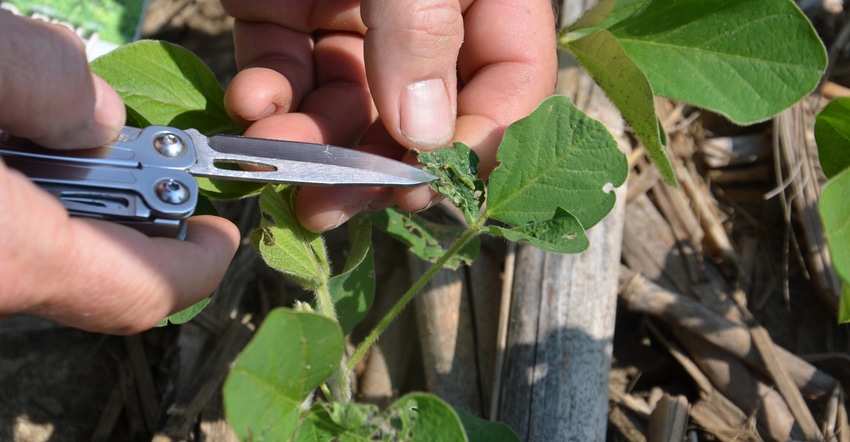
A good soybean scout knows when to get excited and when to remain calm. Steve Gauck passes that advice along to anyone who walks soybean fields throughout the season, especially if they haven’t walked many fields before.
“You may see some leaf feeding from various insects, even fairly early in the season,” he explains. “However, plants in the vegetative stage can withstand a large amount of leaf feeding before it really impacts yield. When plants get to the reproductive stage, leaf damage is more critical. Recommendations usually suggest treating for pests if they’re present at lower levels of defoliation during reproductive stages than during vegetative stages.”
Gauck is a regional agronomy manager for Beck’s, based near Greensburg, Ind. Beck’s sponsors Soybean Watch ’20. This project follows the progress of one field in central Indiana during the growing season, looking for observations that might be useful in your soybean management program, no matter where you farm.
At press time, the Soybean Watch ’20 field was not yet planted, due to wet soils. It’s located is in one of the wettest pockets in Indiana this spring. This story is based on observations from previous Soybean Watch fields and may match up with what you’re seeing in your own fields now or could see soon.
Insect feeding
The first generation of bean leaf beetles creates holes in young soybean leaves. Plants are usually in the vegetative stage, Gauck says. Bean leaf beetle adults can be yellow, tan or red. They may or may not have black spots on their wing covers, but all have a black triangular mark behind the head. For a more complete description and scouting information, refer to the Purdue University Extension Corn & Soybean Field Guide.
“It takes more than 40% defoliation in vegetative, prebloom stages before you would be justified economically to spray for them,” Gauck says. That doesn’t happen often. However, there are two generations per year. The second generation may be feeding during reproductive stages. From beginning bloom through beginning seed fill, stages R1 through R5, treatment is recommended if there is only 15% or more defoliation.
“It’s a lot more critical at that stage, because plants are beginning to fill pods,” Gauck says.
He notes, however, that these percentages refer to total defoliation of the entire plant, not just of a leaflet or a set of trifoliate leaves. “It takes a lot of lost leaf tissue to amount to 40% across the entire plant when you’re scouting early in the season,” he notes.
Another pest you may encounter, usually closer to July 1, is the green cloverworm. Look for a pale yellow to green larva, usually feeding on a leaf. They can chew up leaf tissue, reducing leaf surface area available to capture sunlight for photosynthesis.
“What really matters, though, is the same as with the bean leaf beetle,” Gauck says. “How much total leaf tissue per plant are they destroying?
“You want to know what’s in the field. Sometimes a localized outbreak could reach threshold levels. Most of the time, however, the damage may look unsightly, but it may not be that important, as far as affecting final yield.”
About the Author(s)
You May Also Like




